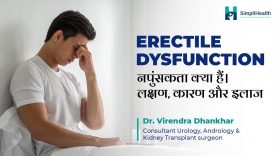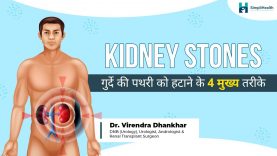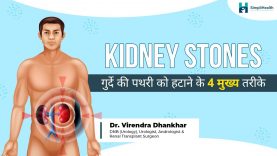Dr. Virendra Dhankhar
Dr. Virendra Dhankhar
Lithotripsy Treatment for Kidney Stone: लिथोट्रिप्सी तकनीक क्या है?
In this video SimpliHealth expert Dr. Virendra Dhankhar explains about Lithotripsy Treatment for Kidney Stone. The patient is made to lie down on a machine(लिथोट्रिप्सी मशीन). The software generated the shock waves that are focused on the stone. Now because these ultrasound-guided shock waves, when focused on the stones, help to break it. It usually requires two to three sittings. If three sessions are not enough to break the stone, then the procedure is a failure. The broken-down stones are then removed from the patient’s body on their own. This may take up to 3 months. If it takes more than three months, then we call it the failure of the procedure.
What are the advantages of lithotripsy(लिथोट्रिप्सी)?
The patient does not need to be hospitalized for this. No anesthesia is needed. It is a non-invasive surgery. So these are the advantages of lithotripsy. The success rate of lithotripsy is 80-90% depending on other factors.
So when should we opt for kidney stones treatment(किडनी स्टोन ऑपरेशन) by Lithotripsy?
- The stone is 1.5cm
- When it is in the pelvic, middle calyx, or upper calyx
- Density is greater than 800Hu
- The patient has two functioning kidneys
- The patient stays close to the hospital
In the rare 5% cases in lithotripsy, additional procedures are required. For example, if the broken kidney stones settle at the pipe below and it causes major pain, then stenting or ureteroscopy is required. 90% is the success rate and 5% chance of getting an additional procedure.
The patient does not need to be hospitalized. No anesthesia is required—90% success rate. Multiple settings can be required. 5% chance of getting an additional procedure done. 1.5 cm stone in the upper or middle calyx, which is 800Hu, the patient stays close to the hospital, does not take any blood thinners, the patient is not obese, then we opt for lithotripsy.
Contradiction of lithotripsy:
The patient is a child and needs multiple anesthesias, the patient is obese, he is on blood thinners, or the patient only has one kidney. The stone is bigger than 1 cm and is located in the lower calyx. In all these conditions, lithotripsy is avoided.















Comments (0)